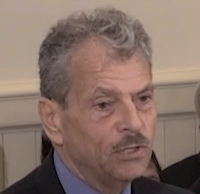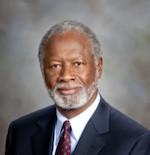Hostility to renewables was part of the reason
Then-PUCO Chair Sam Randazzo testifies as an interested party regarding House Bill 6 before the Ohio House Energy and Natural Resources Committee on May 7, 2019. Source: Ohio Channel.
Late last year, as his administration was plunging deeper into a scandal over a nuclear bailout, Ohio Gov. Mike DeWine said he supported keeping the billion-dollar ratepayer subsidy even though the original deal creating them was part of a $61 million bribery and money-laundering scheme.
The governor said he supported scrapping the law creating the billion-dollar subsidy, but the subsidy itself should be kept in place for environmental reasons.
“One (reason) is at least 85% of our non-carbon production in the state of Ohio is nuclear,” DeWine said. “If you get rid of that, you’ve totally changed your percentage that is non-carbon. You’re virtually down to nothing. So that doesn’t seem like a great idea.”
But the governor didn’t seem so concerned with carbon-free energy production when he appointed Sam Randazzo to the state’s top regulator, the Public Utility Commission of Ohio.
Before Randazzo’s appointment, five environmental groups on Feb. 1, 2019 took a possibly unprecedented step: They sent a letter to DeWine urging him to pick somebody else.
Even when they’re unhappy with prospective regulators, the groups are reluctant to publicly oppose them. That’s because they want to be heard as regulators make far-reaching decisions about renewable energy, conservation and the like.
But they judged Randazzo, who had long experience representing industrial customers before the PUCO, to be so bad that they had to speak up.
“I’ve been doing this work for 30 years and we’ve never opposed a commissioner and we’re a regional organization, so this was highly, highly unusual,” said Rob Kelter, senior attorney at the Environmental Law and Policy Center.
The organization operates in Ohio, Iowa, Minnesota, Indiana, Wisconsin, Michigan and Illinois, as well as in North and South Dakota. So, at least in Kelter’s experience over three decades in nine states, Randazzo’s was the first regulatory appointment to which the law and policy center publicly objected.
“There have been a number of commissioner appointments over the years that we were not thrilled with,” Kelter said. “But Sam Randazzo… was very anti-clean energy. He disliked renewable energy and energy efficiency and he was always saying that markets would work and people would invest if it makes economic sense for them and we should let the markets work. Well, our society has subsidized coal and nuclear for years.”

In a deferred prosecution agreement last month, FirstEnergy and federal prosecutors said that Randazzo helped to dramatically increase subsidies for both during his tenure at the PUCO.
As a pro-business, mainline Republican, it’s not all that surprising that DeWine wasn’t all that interested in the advice of environmentalists. But DeWine not only ignored them, he made Randazzo chairman of the regulatory body.
The decision hasn’t aged well.
FirstEnergy last month admitted paying Randazzo $22 million over the years — including $4.3 million just weeks before he took the regulatory reins. The deferred prosecution agreement FirstEnergy signed with federal prosecutors seems to indicate that Randazzo saw himself more as a servant of the massive utility than the top protector of Ohio ratepayers.
Randazzo has not been charged and through his lawyer he last week again denied wrongdoing.
But the agreement signed by FirstEnergy describes how its top two — subsequently fired — executives met with Randazzo at his Columbus condo on Dec. 18, 2018. Randazzo had just informed them that Governor-elect DeWine was seeking applications to be utility commissioner and that he was in the running to become one — perhaps even the chairman.
The next day, after the energy officials told Randazzo they would pay him $4.3 million under an earlier consulting agreement, Randazzo texted them back, pledging his loyalty.
“Made me laugh – you guys are welcome anytime and any whereI [sic] can open the door. Let me know how you want me to structure the invoices. Thanks,” the message said.
The prosecution agreement goes on to detail a number of doors Randazzo allegedly opened for FirstEnergy.
It accuses Randazzo of helping to write the bailout legislation, which in addition to subsidizing two nuclear plants, also provided FirstEnergy with a “decoupling” subsidy worth $102 million a year. And by derailing a rate review scheduled for 2024, Randazzo’s efforts promised to keep the subsidy in place well into the future, the deferred prosecution agreement says.
Perhaps even more galling to the environmental groups, the bailout legislation also provided subsidies for two 66-year-old coal-fired plants — including one that isn’t even in Ohio.
The bailout legislation, House Bill 6, also gutted standards for renewables and energy efficiency. Even before the scandal broke last summer, what was known about HB 6 prompted the news organization Vox to call it “the worst energy bill of the 21st century.”
As with so many other aspects of HB 6, propping up coal plants and cutting efficiency and renewable standards only gets uglier with age. The International Panel on Climate Change on Monday published a report saying that climate-related disasters are upon us and if we don’t urgently work to reduce carbon emissions they’ll be far more cataclysmic in the future.
Kelter, of the Environmental Law and Policy Center, said that despite DeWine’s claims of wanting carbon-free generation, his administration wasn’t interested in anything other than nuclear power.
“When we met with the governor’s people right after his election, we asked them to do two things: We asked them to oppose the nuclear bailout and they said that that was not under consideration because the governor had made a commitment to bail out the nuclear plants during the course of the campaign,” Kelter said.
“The second thing we asked them to do is support renewable energy and energy efficiency and they said they would not take any positions on renewable energy or energy efficiency and that their sole focus was bailing out the nuclear plants.”

DeWine Press Secretary Dan Tierney said the governor has long been a supporter of nuclear energy.
“If you did want to go to a significantly carbon-free generation mechanism in Ohio you could not do that solely through renewables because you can’t produce the amount of energy this state needs,” Tierney said. “You have to have nuclear as part of the mix if you’re going to have any significant amount of carbon-free generation.”
So why not support wind and solar and efficiency and nuclear? Tierney said that depends on the details.
“The downsides of the policy might outweigh the upsides of the policy,” he said.
Kelter said Randazzo’s hostility to renewables and conservation was only part of his objection to appointing the consultant to be a regulator. Kelter said he also was disturbed by what appeared to be a close relationship with FirstEnergy that seemed to consistently yield deals that favored Randazzo’s industrial clients at the expense of residential and small-business customers.
“In the letter (to DeWine) we focused on his positions on renewable energy and his bias towards fossil fuels and nuclear, but there’s no question that one of my big concerns was his relationship with FirstEnergy,” Kelter said.
• • •• • •
This story is provided by Ohio Capital Journal, a part of States Newsroom, a national 501 (c)(3) nonprofit. See the original story here.














